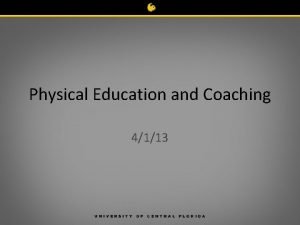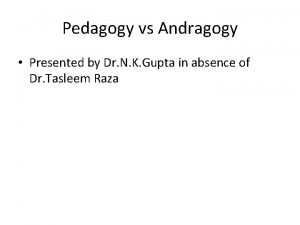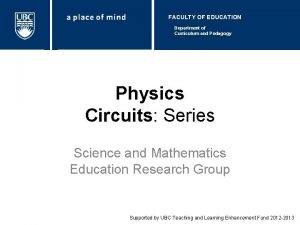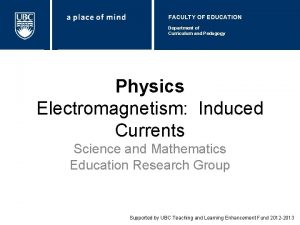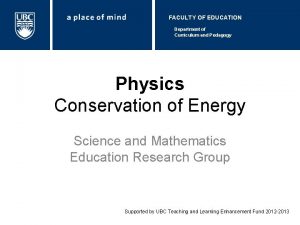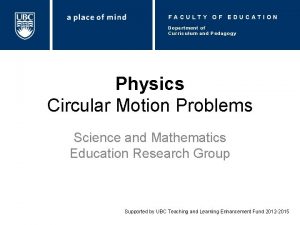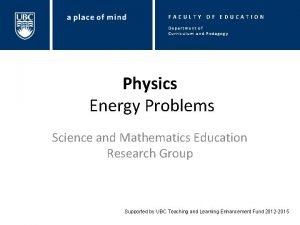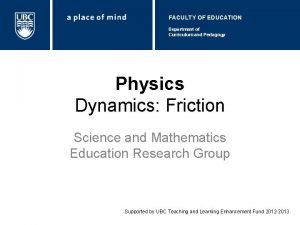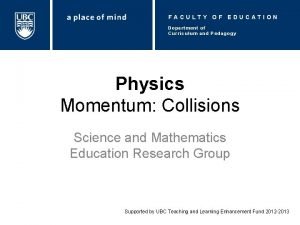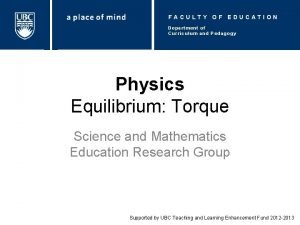FACULTY OF EDUCATION Department of Curriculum and Pedagogy














- Slides: 14

FACULTY OF EDUCATION Department of Curriculum and Pedagogy Physics Momentum Science and Mathematics Education Research Group Supported by UBC Teaching and Learning Enhancement Fund 2012 -2015

Momentum Question Title http: //www. physicsclassroom. com/class/momentum/Lesson-2/Using-Equations-as-a-Guide-to-Thinking

Momentum Question Title The following questions have been compiled from a collection of questions submitted on Peer. Wise (https: //peerwise. cs. auckland. ac. nz/) by teacher candidates as part of the EDCP 357 physics methods courses at UBC.

Momentum Problems I Question Title A bumper car is initially driving to the right at 5 m/s. After bouncing off a wall, the bumper car is moving backwards (to the left) at 3 m/s. The car, including driver, is 100 kg. What is the change in momentum? (Consider moving to the right as moving in the positive direction) A. 800 kg m/s Before B. 500 kg m/s C. 300 kg m/s D. -500 kg m/s E. -800 kg m/s After

Solution Question Title

Momentum Problems II Question Title Before A. The collision is perfectly elastic. A B B. Total momentum is conserved. C. The system is closed. D. None of the above. After A B

Solution Question Title

Solution Questioncontinued Title

Momentum Problems III Question Title There is a collision between two 1 kg carts. One is initially moving at 5 m/s and the other is initially at rest. With the information provided, can we solve for the final velocities of the carts? A. Yes, we can use the law of conservation of momentum. B. Yes, we can use the law of conservation of energy. C. Yes, we can use the law of the conservation of momentum and the conservation of energy. D. No, we cannot apply the law of conservation of energy.

Solution Question Title Answer: D Justification: The law of conservation of energy states that, in a closed system (isolated from its surroundings), the total energy of the system is conserved. In our case, we cannot apply the law of conservation of energy, because we don't know whether the collision is elastic or inelastic. Also, the law of conservation of momentum states that the total momentum of a closed system does not change. That is, the total momentum of the objects before the collision is the same as the total momentum of the objects after the collision. By using the law of conservation of momentum, we are unable to determine the final velocities of the carts, as shown on the next slide.

Solution Questioncontinued Title Law of conservation of momentum Application of the law

Momentum Problems IV Question Title Two objects (A and B) of different mass are moving in opposite directions, but at the same speed, before a head-on collision. Object A is three times more massive than object B. After the collision: object A comes to rest; the direction of object B is reversed and its speed is increased by a factor of 2. Is the momentum conserved in this collision? Is the kinetic energy conserved? A. Only the total momentum is conserved. B. Only the kinetic energy is conserved. C. Both kinetic energy and total momentum are conserved. D. Total momentum is conserved, but not the kinetic energy E. Kinetic energy is conserved, but not the total momentum

Solution Question Title Answer: C Justification: Before B A Collision A After A B B

Solution Questioncontinued Title
 Education scotland play pedagogy toolkit
Education scotland play pedagogy toolkit Sa-sams marksheets 2020
Sa-sams marksheets 2020 Nit calicut chemistry department
Nit calicut chemistry department Tapp teacher certification
Tapp teacher certification Physical activity and sport pedagogy definition
Physical activity and sport pedagogy definition Advanced pedagogy and application of ict book pdf
Advanced pedagogy and application of ict book pdf Epistemology and pedagogy
Epistemology and pedagogy Importance of faculty in higher education
Importance of faculty in higher education York university myfile
York university myfile Faculty of education
Faculty of education Chronicle of higher education faculty salaries
Chronicle of higher education faculty salaries Faculty of education khon kaen university
Faculty of education khon kaen university Techno-pedagogy
Techno-pedagogy Public pedagogy definition
Public pedagogy definition Pedagogies meaning
Pedagogies meaning




